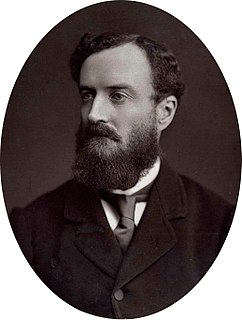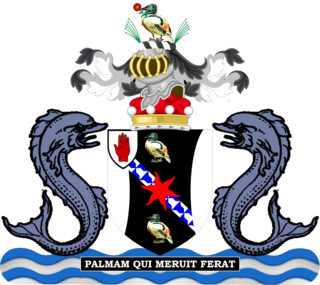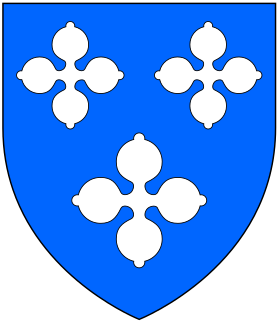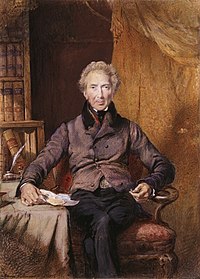
Marquess of Linlithgow, in the County of Linlithgow or West Lothian, is a title in the Peerage of the United Kingdom. It was created on 23 October 1902 for John Hope, 7th Earl of Hopetoun. The current holder of the title is Adrian Hope.

Earl of Minto, in the County of Roxburgh, is a title in the Peerage of the United Kingdom. It was created in 1813 for Gilbert Elliot-Murray-Kynynmound, 1st Baron Minto. The current earl is Gilbert Timothy George Lariston Elliot-Murray-Kynynmound, 7th Earl of Minto.

Earl St Aldwyn, of Coln St Aldwyn in the County of Gloucester, is a title in the Peerage of the United Kingdom. It was created in 1915 for the prominent Conservative politician Michael Hicks Beach, 1st Viscount St Aldwyn, known from 1854 to 1907 as Sir Michael Hicks Beach, 9th Baronet, of Beverston. He was Chancellor of the Exchequer from 1885 to 1886 and again from 1895 to 1902. Hicks Beach had already been created Viscount St Aldwyn, of Coln St Aldwyn in the County of Gloucester, in 1906, and was made Viscount Quenington, of Quenington in the County of Gloucester, at the same time he was given the earldom. Both titles are in the Peerage of the United Kingdom. He was succeeded by his grandson, the second Earl, the son of Michael Hicks Beach, Viscount Quenington, Member of Parliament for Tewkesbury, who was killed in action in 1916. Lord St Aldwyn was also a Conservative politician and was Captain of the Honourable Corps of Gentlemen-at-Arms between 1958 and 1964 and 1970 and 1974. As of 2018 the titles are held by his eldest son, the third Earl, who succeeded in 1992.

Baron Bagot, of Bagot's Bromley in the County of Stafford, is a title in the Peerage of Great Britain. It was created on 12 October 1780 for Sir William Bagot, 6th Baronet.

Baron ffrench, of Castle ffrench in the County of Galway, is a title in the Peerage of Ireland created on 14 February 1798 for Rose, Lady ffrench. She was the widow of Charles ffrench, who had been created a Baronet, of Clogha in County Galway, in the Baronetage of Ireland on 17 August 1779. Their son Thomas succeeded in both the baronetcy and barony. Both titles have descended via primogeniture to the present Baron.

Baron Henniker, of Stratford-upon-Slaney in the County of Wicklow, is a title in the Peerage of Ireland. It was created in 1800 for Sir John Henniker, 2nd Baronet, who had previously represented Sudbury and Dover in the House of Commons. His son, the second Baron, also sat as a Member of Parliament. In 1792 he assumed by Royal licence the additional surname of Major. He was childless and was succeeded by his nephew, the third Baron. He assumed the additional surname of Major by Royal licence in 1822. His son, the fourth Baron, represented Suffolk East in Parliament. In 1866 he was created Baron Hartismere, of Hartismere in the County of Suffolk, in the Peerage of the United Kingdom. This title gave him and his descendants an automatic seat in the House of Lords. He was succeeded by his son, the fifth Baron. He also sat as Member of Parliament for Suffolk East and later held minor office in the Conservative administrations of Benjamin Disraeli and Lord Salisbury. His grandson, the eighth Baron, was a prominent diplomat and notably served as British Ambassador to Jordan and to Denmark. As of 2014 the titles are held by the latter's son, the ninth Baron, who succeeded in 2004.

Baron Henley is a title that has been created twice: first in the Peerage of Great Britain and then in the Peerage of Ireland. The first creation came in 1760 in favour of Sir Robert Henley, Lord High Chancellor of Great Britain, when he was created Lord Henley, Baron of Grainge, in the County of Southampton. In 1764 he was further honoured when he was made Earl of Northington. On the death of his son, the second Earl, both titles became extinct. Lady Elizabeth Henley, youngest daughter of the first Earl and co-heiress of the second Earl, married the diplomat Morton Eden. In 1799, the Henley title was revived when Eden was created Baron Henley, of Chardstock in the County of Dorset, in the Peerage of Ireland. Their son, the second Baron, assumed the surname of Henley in lieu of Eden and notably published a biography of his maternal grandfather. His son, the third Baron, sat as Liberal Member of Parliament for Northampton. In 1885 the Northington title was also revived when he was created Baron Northington, of Watford in the County of Northampton, in the Peerage of the United Kingdom. This title gave the Barons an automatic seat in the House of Lords. The fourth baron Frederick Henley was an educated man who served as JP in Northamptonshire and married Augusta, daughter of Herbert Langham 12th baronet.
Baron Huntingfield is a title that has been created three times, twice in the Peerage of England and once in the Peerage of Ireland. The first two creations were by writ, but little more is known about them, except that John de Huntingfield, who was created Baron Huntingfield in 1362, married Margery de Welles, daughter of John de Welles, 4th Baron Welles. John was dead by December 1376, when Margery remarried. Both titles probably became extinct or fell into abeyance on the death of their first holders. The third creation, Baron Huntingfield, of Heveningham Hall in the County of Suffolk, was created in the Peerage of Ireland in 1796 for Sir Joshua Vanneck, 3rd Baronet, Member of Parliament for Dunwich. His son, the second Baron, also represented this constituency in the House of Commons. His great-grandson, the fifth Baron, was Conservative Member of Parliament for Eye and Governor of Victoria. As of 2013 the titles are held by the latter's grandson, the seventh Baron, who succeeded his father in 1994.
Baron Hayter, of Chislehurst in the County of Kent, is a title in the Peerage of the United Kingdom. It was created in 1927 for the businessman Sir George Chubb, 1st Baronet. He had already been created a baronet of Newlands in the Baronetage of the United Kingdom in 1900. Chubb was chairman and managing director of the firm Chubb and Sons Lock and Safe Co Ltd, established by his grandfather Charles Chubb in the early 19th century. "Hayter" was the maiden name of George Hayter Chubb's mother, and was selected in preference to "Chubb", as it was not considered appropriate for names of corporations to be attributed to members of the House of Lords. He was succeeded by his son, the second baron. He was managing director of Chubb and Sons Lock and Safe Co Ltd. His son, the third baron, was managing director and chairman of Chubb and Sons Lock and Safe Co Ltd and also served as deputy chairman of the House of Lords from 1981 to 1995. As of 2014 the titles are held by the latter's son, the fourth baron, who succeeded in 2003.

Baron Hesketh, of Hesketh in the County Palatine of Lancaster, is a title in the Peerage of the United Kingdom. It was created in 1935 for Sir Thomas Fermor-Hesketh, 8th Baronet, who had previously briefly represented Enfield in the House of Commons as a Conservative. As of 2010 the titles are held by his grandson, the third Baron, who succeeded his father in 1955. Lord Hesketh held junior ministerial positions in the Conservative administrations of Margaret Thatcher and John Major. However, he lost his seat in the House of Lords after the House of Lords Act 1999 removed the automatic right of hereditary peers to sit in the upper chamber of Parliament.

Baron Glenarthur, of Carlung in the County of Ayr, is a title in the Peerage of the United Kingdom. It was created in 1918 for the Scottish businessman Sir Matthew Arthur, 1st Baronet. He had already been created a baronet, of Carlung in the County of Ayr, on 28 November 1902. The title of the barony was derived from the joining of his mother's maiden surname name of Glen and his patronymic Arthur.

Baron Avebury, of Avebury in the County of Wiltshire, is a title in the Peerage of the United Kingdom. It was created 22 January 1900 for the banker, politician and archaeologist Sir John Lubbock, 4th Baronet. He was succeeded by his eldest son, the second Baron. On his death the titles passed to his nephew, the third Baron. He was the son of Harold Fox Pitt Lubbock, fourth son of the first Baron, who died in 1971. The title then passed to the third Baron's first cousin, the fourth Baron, the son of Maurice Fox Pitt Lubbock, sixth son of the first Baron. The fourth baron was a Liberal Democrat politician and one of the ninety excepted hereditary peers who remained in the House of Lords after the passing of the House of Lords Act 1999. He was succeeded by his son, the fifth Baron, in 2016.
Baron Wolverton, of Wolverton in the County of Buckingham, is a title in the Peerage of the United Kingdom. It was created in 1869 for the banker George Glyn. He was the fourth son of Sir Richard Carr Glyn, 1st Baronet, of Gaunt's House, Lord Mayor of London in 1798, himself the fourth son of Sir Richard Glyn, 1st Baronet, of Ewell, Lord Mayor of London in 1758. Lord Wolverton was succeeded by the eldest of his nine sons, the second Baron. He was a Liberal politician and served under William Ewart Gladstone as Paymaster-General and as Postmaster General. He was childless and was succeeded by his nephew, the third Baron. He was the eldest son of Vice-Admiral the Hon. Henry Carr Glyn, younger son of the first Baron. He died childless the following year aged only twenty-six, and was succeeded by his younger brother, the fourth Baron. He served as Vice-Chamberlain of the Household from 1902 to 1905 in the Conservative administration of Arthur Balfour. On the death in 1988 of his second but eldest surviving son, the fifth Baron, this line of the family failed. The title was inherited by the late Baron's second cousin, the sixth Baron. He was the grandson of the Hon. Pascoe Glyn, younger son of the first Baron. As of 2011 the title is held by his grandson, the eighth Baron, who succeeded in 2011.

Baron Cottesloe, of Swanbourne and Hardwick in the County of Buckingham, is a title in the Peerage of the United Kingdom. It was created on 2 March 1874 for the Conservative politician and former Chief Secretary for Ireland, Sir Thomas Fremantle, 1st Baronet (1798–1890). He was the son of Admiral Sir Thomas Fremantle (1765–1819). Lord Cottesloe had already been created a Baronet, of Swanbourne in the County of Buckingham, on 14 August 1821, chiefly in recognition of his father's services, and with remainder to the latter's heirs. His father Sir Thomas Fremantle was created Baron Fremantle, of the Austrian Empire, which Lord Cottesloe inherited in 1819 with the death of his father. Subsequently, in 1822 he was given a Royal licence, which authorized him and his successors to use the title in Britain. However, a warrant issued on 27 April 1932 withdrew all the royal licences, only allowing the use of the title to the then current holders, their heir and their heir's heir. The fifth baron was the last holder being allowed to use the Austrian title in the United Kingdom.

Baron Remnant, of Wenhaston in the County of Suffolk, is a title in the Peerage of the United Kingdom. It was created on 26 June 1928 for the Conservative politician Sir James Remnant, 1st Baronet, who had previously represented Holborn in the House of Commons. He had already been created a Baronet, of Wenhaston in the County of Suffolk, on 14 July 1917. As of 2022 the titles are held by his great-grandson, the fourth Baron, who succeeded his father in that year.

John Shore, 1st Baron Teignmouth was a British official of the East India Company who served as Governor-General of Bengal from 1793 to 1798. In 1798 he was created Baron Teignmouth in the Peerage of Ireland.

Marquess of Ripon, in the County of York was a title in the Peerage of the United Kingdom. It was created in 1871 for the Liberal politician George Robinson, 2nd Earl of Ripon.

There have been three baronetcies created for persons with the surname Croft, one in the Baronetage of England and two in the Baronetage of the United Kingdom. All three creations are extant as of 2008.

Viscount D'Abernon, of Esher and of Stoke d'Abernon in the County of Surrey, was a title in the Peerage of the United Kingdom. It was created on 20 February 1926 for the politician, diplomat and writer Edgar Vincent, 1st Baron D'Abernon who had been created Baron D'Abernon, of Esher in the County of Surrey, on 2 July 1914. In 1936 he succeeded his elder brother as sixteenth Baronet, of Stoke d'Abernon. All three titles became extinct on his death in 1941.
Baron Dunleath, of Ballywalter in the County of Down, is a title in the Peerage of the United Kingdom. It was created on 29 August 1892 for the businessman and former Conservative Member of Parliament for Downpatrick, John Mulholland. The Mulholland family were involved in the cotton and linen industry in Ulster in the north of Ireland. The first Baron's son, the second Baron, represented Londonderry North in the House of Commons as a Conservative. His grandson, the fourth Baron, was a member of the Northern Ireland Assembly for the Alliance Party. He was succeeded by his first cousin, the fifth Baron, who had already succeeded his father as second Baronet of Ballyscullion. As of 2017 the titles are held by the fifth Baron's son, the sixth Baron, who succeeded in 1997.
















